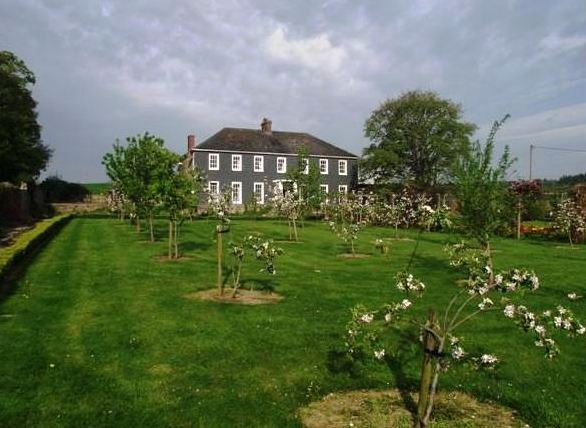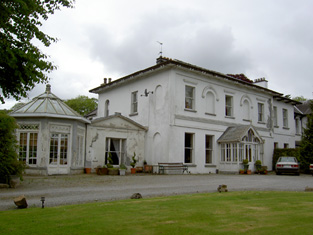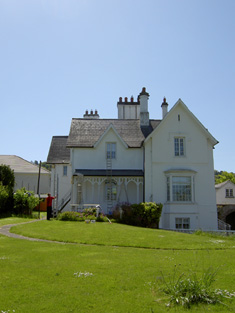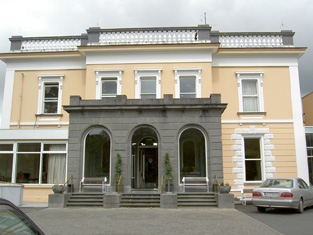Glenconnor
Houses within 5km of this house
Displaying 32 houses.
Houses within 5km of Glenconnor
Displaying 32 houses.
| House name | Description | |
|---|---|---|
| Marlhill | This house was the residence of Robert Prendergast in 1814. In 1840 the Ordnance Survey Name Books also record it as his residence under the slightly variant name of Marlow Hill. James Prendergast held the house valued at £12.15 shillings from the Reverend John Bagnell with 182 acres in the mid 19th century [see Bagnell entry in ''Burkes Irish Family Records'']. Home of the Rice family from the 1860s. A building still stands at this site. | |
| Coole | A house with a gatelodge marked on the first Ordnance Survey map and located just north of Knocklofty. Occupied by Thomas Morrissey in the mid 19th century, held from the Earl of Donoughmore and valued at £16+. A building is still extant at this location. | |
| New Abbey | In 1786 Wilson refers to New-Abbey as the seat of Moore Cootee. He notes that the house was close to "the great flour mills built by the late Stephen Moore". New-Abbey was occupied by Henry Moore in the mid 19th century and held from Stephen Moore, the buildings were valued at £11.16 shillings. | |
| Salisbury | Stephen Moore is recorded as resident here in 1814 and T. Sadlier in 1837. The christian name of the mother of Stephen Moore was Salisbury. By the time of Griffith's Valuation John Bagwell held the house in fee. It was valued at £18+. Percy Gough of Salisbury, Clonmel, owned 724 acres in King's County in the 1870s. Slater refers to "Inislonagh House" as the seat of Lt-Gen. Sir Charles J. Gough in 1894. Bence Jones writes that this house was leased to J.W. Cleeve in the early 20th century and from the late 1920s to Sir David O'Brien 6th Baronet. |

|
| Oaklands | William Ryal was living at Oakland, Clonmel, in 1814 and Mr Bagwell in 1837. Colonel Phipps was resident at the time of Griffith's Valuation, holding the house valued at £49.10 shillings from John Bagwell. Still occupied as a residence. |

|
| Haywood | A house situated on the northern outskirts of the town of Clonmel, the home of Charles Riall in the first half of the 19th century. It appears to straddle the parish border between Rathronan and St Mary's Clonmel. The residence of John Riall in the 1870s. The site is now occupied by a shed. | |
| Silver Spring House | This building was originally a charter school. By the mid 19th century it was occupied by Charles Bianconi, valued at £16 and held from Mrs Putland and Sir Charles Hulse. Mrs Anne Moore lived here in the 1870s. It is no longer in use. |

|
| E.T.M. Ville | E.T.M. Ville, Clonmel was occupied by E.T.M. Butler [Edmond Theobald Mandeville Butler] in 1814 and by his widow Mrs Eliza Butler in the mid 19th century. The house was then valued at £13 and held from the Putland/Hulse estate. Some buildings remain at the site. | |
| Ballingarrane | Ballingarrane was originally leased and then purchased in the late 18th century by Solomon Watson, banker of Clonmel. He built Summerville House which later became known as Ballingarrane. W. H. Bradshaw occupied the house in 1837 and John Mulcahy in the mid 19th century when the buildings were valued at £25+ and held from Solomon Watson. The Watsons occupied the house again in the second half of the 19th century and family members were still resident in the late 20th century. |

|
| Barn | The seat of the Moore family in the 18th, 19th and 20th centuries. In 1786 Wilson refers to it as the seat of Thomas Moore In 1840 the Ordnance Survey Letter Books note that it had "a garden nursery and ornamental ground". It was held by Stephen Moore in fee in the mid 19th century and valued at £49+. Randal K. Moore was resident in 1906 and Mr and Mrs Murray Moore in the early 1940s when the house contained a very fine library and antique art collection. Barn is still extant. |

|
| Orchardstown | The home of the Hamerton family in the 19th century, occupied by John Hamerton in 1814. Mathew Hamerton was the occupier in the early 1850s holding the house from Major William M. Hamerton. The buildings were valued at £18+. | |
| Rathronan House | A property granted to John Walsh in 1679. Lewis describes this house as the "elegant residence of Major General Sir Hugh Gough". Viscount Gough was still resident in the mid 19th century when the buildings were valued at £47+ and held from Major William M. Hamerton. This property was in the possession of the Whalley family in the late 19th century. A house is still extant at the site. | |
| Melview | A house on the outskirts of Clonmel, occupied by Robert Malcomson in the mid 19th century, held from John Bagwell and valued at £52. This building now functions as a nursing home. |

|
| Powerstown | The residence of George Green in 1814 and in the early 1850s when the buildings were valued at £26+ and held from Mrs Putland and Sir Charles Hulse. This house no longer exists. | |
| Rathduff | A house occupied by Thomas Kennedy and held from the Reverend John W. Hackett and partners in the mid 19th century when the buildings were valued at £16.15 shillings. | |
| Bird Hill | A house located on the outskirts of Clonmel town was the residence of a member of the Taylor family in 1837. At the time of Griffith's Valuation this house valued at £10.12 shillings was occupied by Margaret Cantwell and held from Stephen Moore with 7 acres of land. This house is still in use as a residence. | |
| Glenabbey House | Leased from Richard Carey by Garrett R. Carey at the time of Griffith's Valuation, when it was valued at almost £8. | |
| Kilnamack | In 1849, the representatives of John Greene were leasing this property to Edward Butler when it was valued at £12 11s. Both Wilson and Taylor and Skinner had also recorded it as a residence of the Greene family in the 1780s. It is still extant and in 2013 was offered for sale. |

|
| Kilgainy | In 1850 Ralph Osborne was leasing this property to Henry Pedder when it was valued at £18 5s. It is labelled Kilgainy on the 25-inch Ordnance Survey Map of the 1890s. It is no longer extant. | |
| Spring Field (Clonmel) | Francis Prittie was leasing this property from the representatives of E. Labarte in 1850. It was then valued at £32 10s. It is still extant and occupied. |

|
| Merlin | In 1850 Abraham Grubb held this property in fee when it was valued at £54. Merlin is still extant and occupied. |

|
| Rose Ville (Clonmel) | At the time of Griffith's Valuation, Mrs. Anne Murray was leasing this property from Abraham Grubb when it ws valued at £33. The National Inventory of Architectural Heritage states that it was designed by Tinsley for the Murray family. Rose Ville has been in use as the Loreto convent since 1881. |

|
| Ashbourne (Clonmel) | In 1850 William Davis was leasing this property from Abraham Grubb when it was valued at almost £36. The National Inventory of Architectural Heritage indicates it was designed by William Tinsley for the Davis family. It is still extant and occupied. |

|
| Fairyhill House (Clonmel) | Leased by Thomas Hughes to David Franks at the time of Griffith's Valuation in 1850 when it was valued at almost £27. Fairy Hill is still extand and occupied. |

|
| Spa Ville | Cuffe Wall was leasing this property to Mrs. Susan Vowel at the time of Griffith's Valuation, when it was valued at £15 10s. It is labelled Spaville on both the 1st edition and later 25-inch edition Ordnance Survey maps. A house still exists at the site. | |
| Spa A | Thomas Dee was leasing this property from the Bagwell estate at the time of Griffith's Valuation, when it was valued at £14. | |
| Glenbrook | At the time of Griffith's Valuation, William Smyth was leasing a house and mill complex from the Bagwell estate, then valued at almost £27. By the end of the nineteenth century the mill is no longer functioning and the house has become known as Glenbrook. | |
| Raheen House (Clonmel) | Held in fee by Mrs. Elizabeth Greer at the time of Griffith's Valuation, when it was valued at over £55. It was offered for sale in September 1878 on behalf of William Greer, described as a lunatic, by his guardians. | |
| Little Island | This house was situated on an island in the Suir River in the southern part of Clonmel town. It was the home of the Morton family in the 19th century but is no longer extant. The Reverend James Morton held the house valued at £42 from his father Samuel at the time of Griffith's Valuation. | |
| Minella | This house was built by the Malcomsons in 1863, now a hotel located in county Waterford. http://www.hotelminella.ie/ |

|
| Summerhill | Summer-hill, Clonmel, was the residence of the Reverend George Mills (sic) in 1814. The house was valued at £15+ in the mid 19th century, occupied by Mrs Dorothea Moore and held from the representatives of the Reverend Miles. In the 1870s Dorothea Moore of Dublin owned 288 acres and Henry Moore of Summerhill, Clonmel owned 247 acres in county Tipperary. Lewis refers to the handsome residence of R. Moore in 1837. |

|
| Chancellorstown House | In 1786 Wilson refers to Chancellors' Town as the seat of Mr. Moore. The house and surrounding demesne are shown on the first edition Ordnance Survey map but are not marked on the 25-inch edition of the 1890s. The townland was part of the estate of Stephen Moore at the time of Griffith's Valuation, though the house was leased by the representatives of Joseph Gough to Denis Daly and was valued at £7 10s. Farm buildings occupy the site now. |

